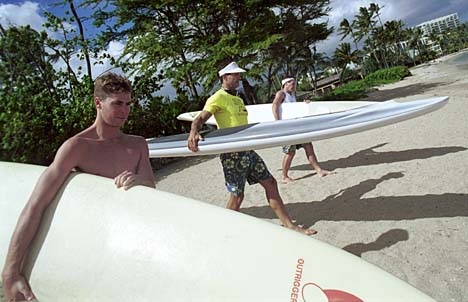

Sunday, April 8, 2001
[PADDLEBOARDING]

Paddleboarding PADDLEBOARDS are a waterman's way of proving he or she can make do with what mother nature dishes out.
back in season
People are breaking out their
paddleboards for the fun of it rather
than just for the health benefitsBy Linda Aragon
Special to the Star-BulletinAs wave heights of winter begin to drop, these rounded-bottom boards that have been hibernating in North Shore garages begin to receive their owner's attention again.
"It's a genuine surf crowd," said Mike Takahashi, race director for the Quiksilver Silver Edition Molokai to Oahu annual paddleboard race. "Before, we used to turn into these flabby mounds of jello (in the summertime). It keeps us in shape," he said.
Riding a paddleboard involves the same stroke as paddling a surf board. Lying on your belly using muscles of the shoulders and arms, the same technique used to catch a wave is applied to riding offshore ocean swells (or bumps).
"It's a fun sport," Takahashi said. "It's an offshoot of surfing for people who get fed up with the crowds. You're out on your own, hopefully, riding this huge open ocean chop."
While Oahu's small community of paddleboarders does include many big wave surfers and hard core distance paddleboard racers, a growing number of people are entering the sport for a variety of reasons like cross-training for canoe paddling, swimming, surfing, and also for the sport's own unique pleasures.
"Anything that's on the water that keeps you out there paddling makes you feel great at the end of the day," said Dale Hope, whose been paddleboarding for the past 30 years.
"You're so close to the water. If you get up that rhythm, as the spray is hitting you in the face, your have the illusion of going so fast," he said.
"It can feel pretty good. It works your arms and shoulders, and it's a good cardio workout. There's also the benefit of being out there and looking at the sea life, and seeing the island from a different perspective."
GETTING STARTED
The equipment is pretty user friendly. To get started all it takes is a paddleboard, although a leash is also recommended, especially for beginners. The board's rounded bottom makes it a bit tippier than a surfboard. However, Hope suggested that a beginner can always build up their balance by first paddling a longboard, which has a flat bottom.Thanks to updated race rules, the 20-pound minimum weight regulation for a 12-foot stock board has been changed. Today new carbon fiber boards that are hollow inside weigh only about 14 pounds for the same 12-foot length.
"It's easier on your body, and so much easier to ride," said Hope. "To do those runs from Hawaii Kai to Waikiki, is such a blast, and on (shaper) Karel Tresnak's new board, it surfs so well I'm not having to paddle."
Many paddlers still opt for the standard solid styrofoam and epoxy board. Especially those wanting a custom-shaped board.
The cost of a new paddleboard starts at about $700 to $900 for a 12-foot carbon board with custom boards of the same length costing approximately $100 more. The unlimited class boards range from 17 to 19-foot boards and cost about $2,000. Surfboard and paddleboard shaper Dennis Pang of Hawaiian Paddleboards said the difference is the longer boards give the rider more glide in the water. However, the paddler must be more efficient with their strokes, as it takes more effort to move the board. The unlimited class model also comes with a rudder system that maneuvers the direction of the board. The stock boards have a single skeg, so the paddler has to use their arms strokes to steer.
SAFETY
There are certain safety tips that most paddlers follow. The most important of these, Hope said, is that you always paddle with another person.Also, you may not want to paddle out further off shore than you could conceivably swim in, just in case your separated from your board.
As with any water sport, it's a good idea to check the surf report before you head out to the water as wind and high surf advisories may affect your decision of where, or whether, you will paddle.
RACES
There are a number of races sponsored in a relatively short racing season from the end of May though July.The race most recommended for novice paddlers is the annual July 4th Sunset Beach to Waimea Bay race. This is the season's shortest course at about 3.4 miles. But with 100 paddlers, this is the largest number of entries of any race all season. This event brings out racers of all abilities and age divisions, including parent/child tandem teams. Also, people enter on all types of paddleboards, even longboards.
The longer distance races build from the 17 mile Cline Mann Makapuu to Waikiki race to the final event of the season, the 32 mile Molokai Channel crossing. Both of these can be raced either solo or as a two-person team relay. These races are open only to experienced paddlers. In keeping with high testosterone levels of the big wave surfer crowd that this sport draws, these races are definitely not for the meek. Paddleboarding "Is definitely the toughest way to cross the Channel," Takahashi said.